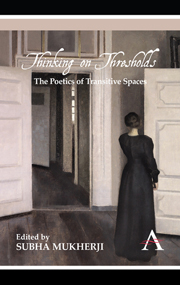Book contents
- Frontmatter
- ACKNOWLEDGEMENTS
- Contents
- List of Illustrations
- Notes on Contributors
- Introduction
- Part One Doors, Windows, Entries
- 1 Windows: Looking In, Looking Out, Breaking Through
- 2 ‘Zero…Zero…and Zero’: Permeable Walls and Off-stage Spaces
- 3 ‘The Queer Part Doors Play’ in Nabokov's Laughter in the Dark
- 4 ‘Invasion from Outer Space’: The Threshold of Annunciations
- Part Two Lives and Narratives, Territories and Worlds
- Part Three Matter, Mind, Psyche
- Part Four Reading, Writing, Playing, Listening
- Select Bibliography (including Discography)
4 - ‘Invasion from Outer Space’: The Threshold of Annunciations
from Part One - Doors, Windows, Entries
Published online by Cambridge University Press: 05 March 2012
- Frontmatter
- ACKNOWLEDGEMENTS
- Contents
- List of Illustrations
- Notes on Contributors
- Introduction
- Part One Doors, Windows, Entries
- 1 Windows: Looking In, Looking Out, Breaking Through
- 2 ‘Zero…Zero…and Zero’: Permeable Walls and Off-stage Spaces
- 3 ‘The Queer Part Doors Play’ in Nabokov's Laughter in the Dark
- 4 ‘Invasion from Outer Space’: The Threshold of Annunciations
- Part Two Lives and Narratives, Territories and Worlds
- Part Three Matter, Mind, Psyche
- Part Four Reading, Writing, Playing, Listening
- Select Bibliography (including Discography)
Summary
In Lino Mannocci's inkjet monotype sequence on the theme of the Annunciation (2009), we are faced with a set of five somewhat uncanny images – familiar yet strange; or the familiar rendered alien. ‘I am the Lord's servant’, the first in the series (Figure 1), is immediately recognisable not only because of the traditional configuration of the angel and Mary facing each other, but also because the angel is Domenico Veneziano's Gabriel, made by cutting out a stencilled image of Veneziano's famous painting of the Annunciation in the Fitzwilliam Museum (Figure 2), around which Mannocci has organised his exhibition of (mainly) Renaissance engravings of the Annunciation, running parallelly. But it is also eerie because, instead of the neat symmetry of that painting, and the clear sense of Gabriel entering Mary's space both in Veneziano and in the pictorial tradition more widely, here we have Mary's tentative half-entry into a frame which is occupied firmly by the angel and his world, including an embryonic cloud floating purposefully down towards Mary, and what looks like a sickle moon peeping out of clouds instead of the harmonious light suffusing Veneziano's canvas. In fact, Mary's kneeling body is half out of the frame, and half in, a position brought to life here by Mannocci's manipulation of his specific craft: using an etching press, paper and a plate, he places Mary's inkjet figure across the plate-mark, rather than within it, before printing, to play with the boundaries.
- Type
- Chapter
- Information
- Thinking on ThresholdsThe Poetics of Transitive Spaces, pp. 43 - 70Publisher: Anthem PressPrint publication year: 2011



